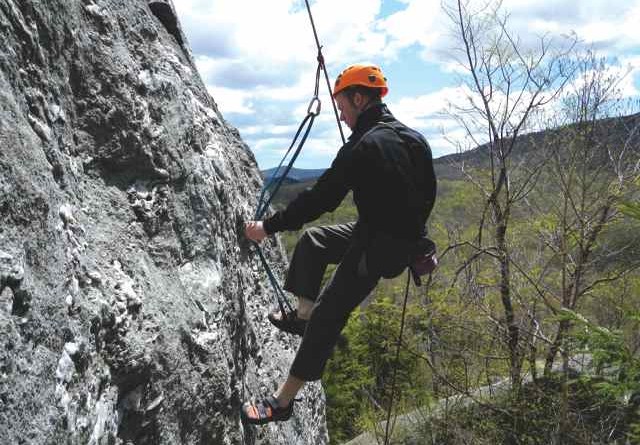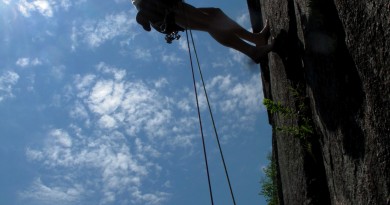Trad Lightly – a gym rat’s pursuit of outdoor rock
KILLINGTON, Vt. — On a late May Monday morning, my legs are going numb in my harness while I cling to a cliff jutting 100 feet above the highway at Sherburne Pass. The wind buffets me in the face while I search the jagged schist with my fingertips for the next handhold.
The rock face is cold and sharp to the touch as I grip with pointer and index fingers trying to find a more secure position. Far below me, the cars on Route 4 look like toys and directly over my shoulder, the slopes of Pico Mountain still have a few patches of late-spring snow. My ankle begins to shake with “sewing machine-effect,” so I adjust, finding a flake just large enough for my toe. I reach behind my hip for my chalk bag to secure my grip.
Fifteen feet above me, my guide, Matthew Conroy, pokes his head over the edge. The wind whips at his shaggy hair as he yells down:
“You’re supposed to be unconscious, don’t move so much.”
“Sorry.”
I resume my dangling, putting my full weight on the rope and feel my legs start to go numb again. Meanwhile, over the cliff edge above me, Matt works with another client to retrieve me. The rope jerks and slowly hauls me upward.
I’m playing the role of “crash test dummy” while we practice rescue techniques for multi-pitch, or “trad,” climbing. The cliff I’m currently hanging from is better suited to the top-rope climbing I’m used to, but for our purposes today, these crags above the Inn at the Long Trail are a great place to practice skills needed for much bigger walls.
Unlike climbing with a top-rope, in which the climbing partner is always secured from falls by a belaying partner above them, “trad” climbing involves setting your own protection in the rock as you climb higher and higher until you eventually “top out” at the top of the cliff or mountain summit.
For this adventure, I joined up with Quechee and Rutland-based Vermont Adventure Tours – one of a handful of outfitters in the state that will lead guided climbing tours to areas in Vermont.
I was excited at the opportunity, and earlier that Monday, I threw my climbing shoes and lunch in a backpack and drove to the trailhead to learn the basics.
Check your technique
I’ve been a casual climber for at least six years, during which I can count on one hand the number of times I’ve climbed on real rock, relying instead on the friendly plastic holds at my local climbing gym. It’s a pastime that keeps me in shape and with decent climbing form.
That said, I admit that when I showed up at the parking lot I might have been a little too confident. I was halfway up the first pitch of the day when Conroy noticed how hard I was breathing.
“On a basic level, indoor and outdoor climbing aren’t really any different as far as the way ropes are set up or what you’re physically doing,” he says. “But the major difference is that route climbing is different from the gym in that the tape isn’t there (to show you the holds) and the holds are in-cut instead of projecting, which is what indoor climbers are used to.”
Depending on the kind of rock you’re climbing, the handholds and footholds found outside the gym offer an infinite variety, but the problem is spotting them — and reaching them. The “real deal” isn’t always as convenient or predictable as the gym.
The point: Your gym climbing can give you the strength and the technique, but when you want to climb rock, you’ll need to go practice and expect to find a significant difference. A 5.8 climb in the gym, for example, is not the same as a 5.8 route outdoors and when I made the first move on the day’s first climb, I realized I had a long way to go. And that’s doubly true for climbers expecting to be able to lead a multi-pitch climb.
NEW SKILL SETS
All climbing demands sound decision making and specific technical skills, including route planning, mitigating risk, organizing and properly using equipment. Instead of going up multiple pitches on our day of climbing, learning as we went, we spent the day working on the skills that would be brought to the bigger walls.
That includes:
- Anchor selection and construction
- Belaying and rappelling from a variety of positions
- Ascending/descending
- Rescue skills, such as escaping a belay or ascending a rope to a distressed climber
To be able to do each of these tasks quickly and with confidence requires frequent practice and constant vigilance.
“You should be able to tie your knots behind your back and with your eyes closed in the dark,” Conroy says.
He’s not joking – in a real environment hundreds of feet above the ground, with darkness, weather and your own fatigue affecting your movement and judgment, you need to stay alert, resourceful and on-task.
So where do you learn these skills and how do you practice them?
Usually with others who have the experience, and that is what makes guiding services an attractive option. For a fee, trained and certified professionals will show you the areas and teach you the skills you need at a pace that’s suitable for you.
Short of that, climbing gyms have message boards where you can find climbing partners or simply a carpool to the local crag. Websites like meetup.com or Facebook can connect you with the climbing community in your area.
“It’s important to go with someone,” says Conroy. “Whether it’s a guide or a knowledgeable friend. Maybe not someone who says they know what they’re doing, but someone who can be recommended (as knowledgeable) and is patient.”
WHERE TO GO?
One of climbing’s biggest challenges is finding good rock faces to climb, and most experienced climbers will admit Vermont isn’t exactly a climbing Mecca. Spots exist, but like so many other sports, it’s a matter of knowing where to go.
While the White Mountains in New Hampshire and the Adirondacks and Shawangunks in New York are widely known hotspots for Northeast climbing, closer options exist.
Deer’s Leap, where Conroy and I were practicing, is a good place for beginners and is within driving distance of Rutland, Killington, Woodstock, Ludlow, Pittsfield, Brandon or Middlebury. There are also a few 70-80-foot cliffs near Lake Dunmore in the Moosalamoo National Recreation Area. In northern Vermont, Bolton hosts a fair number of accessible climbs in the area and is located just half an hour or less from Burlington, Stowe, Waterbury or Montpelier.
In the southern part of the state, Jamaica State park has some climbing routes with easy walk-around access while the Northeast Kingdom has trad and harder sport climbing around Mount Wheeler and the Marshfield Ledge. The quarry area near Barre has sport and mixed climbs with some top rope options. Smugglers’ Notch, connecting Jeffersonville and Stowe, has opportunities for bouldering and multi-pitch climbing, including some tough roofs and overhangs.
Unlike climbing in an artificial environment, your presence has an impact on the area so pay attention to all posted signs, check for climbing bans due to nesting Peregrines, be considerate of where you park your car and, as always, pack-out what you pack-in.
WHAT TO BRING
Gear is necessary, and new, top-of-the-line cams or bolts are expensive. So before you go out and spend hundreds on some slick hardware, focus on the basics like shoes, harness, helmet and chalk. If you have a climbing partner, you can coordinate your purchases to prevent too much “overlap” (just be sure to work out an arrangement for what to do if a piece gets broken, lost, or stuck in a crack, as this will avoid disagreements). Most racks include some or all of the following:
- Cams and tricams
- Wedge nuts or hex nuts
- Cordelettes
- Runners
- Alpine draws of varying lengths
- Carabiners (locking and sport varieties)
- Nut tool (useful for cleaning in deeper cracks, opening beer, etc.)
- Gear sling
When it comes to buying, keep an eye out for deals at your local gear shop and you’ll quickly fill missing gaps.
“Throughout your climbing career, you accumulate gear and you’ll learn what you like and what you don’t like,” Conroy says. “It’s not like there’s a standard list of things you bring every time, it depends what your preferences are and what you’re doing.”
It’s also possible to buy some equipment used. Hard goods, like a carabineers or belay devices have a longer life than soft goods like ropes or harnesses, but it’s best to go by what the manufacturer recommends. And don’t buy used ropes or harnesses.
TOPPING OUT
By the end of the day, I had practiced all of the basics, building mock-anchors, rappelling and even ascending a rope to retrieve the climber I had previously been belaying. My face was sunburnt and the skin on my fingers screamed, but it was a great day outside the gym on the rock. In a few weeks, Matt and another client would take the skills they had practiced to Cannon Mountain in the White Mountains of New Hampshire. Cannon Cliff is argued to be the only “big wall” on the east coast, with a wall roughly 1,000 feet high and a mile long, making it a suitable challenge for any experienced climber looking for remote and challenging multi-pitch climbing.
I still need more practice, but until then, I decided an introduction would serve me well.



